Occurrence and Distribution of Long-Term Variability in Precipitation Classes in the Source Region of the Yangtze River
Abstract
:1. Introduction
2. Materials and Methods
2.1. Study Area
2.2. Data and Methods
3. Results
3.1. Spatio-Temporal Distribution of Precipitation and Rainy Days
3.1.1. Annual Temporal Variations
3.1.2. Variabilities in Seasonal Precipitations
3.1.3. The Spatial Distributions of Precipitation Trends and Rainy Days
3.2. Rainy Day Percentages for Each Precipitation Class
3.3. Variations of Precipitation Amount in Each Precipitation Class
3.4. Relationship between Precipitation Amount and Rainy Days
3.5. Wet Spell Variations
3.6. Dry Spell Variations
4. Discussion
5. Conclusions
Author Contributions
Funding
Informed Consent Statement
Data Availability Statement
Acknowledgments
Conflicts of Interest
References
- Wang, Z.; Sun, S.; Song, C.; Wang, G.; Lin, S.; Ye, S. Variation characteristics of high flows and their responses to climate change in permafrost regions on the Qinghai-Tibet Plateau, China. J. Clean. Prod. 2022, 376, 134369. [Google Scholar] [CrossRef]
- Saeed, U.; Ahmad, S.R.; Mohey-ud-din, G.; Butt, H.J.; Ashraf, U. An Integrated Approach for Developing an Urban Livability Composite Index—A Cities’ Ranking Road Map to Achieve Urban Sustainability. Sustainability 2022, 14, 8755. [Google Scholar] [CrossRef]
- Zheng, G.; Allen, S.K.; Bao, A.; Ballesteros-Cánovas, J.A.; Huss, M.; Zhang, G.; Li, J.; Yuan, Y.; Jiang, L.; Yu, T.; et al. Increasing risk of glacial lake outburst floods from future Third Pole deglaciation. Nat. Clim. Chang. 2021, 11, 411–417. [Google Scholar] [CrossRef]
- Ahmed, N.; Wang, G.; Booij, M.J.; Ceribasi, G.; Bhat, M.S.; Ceyhunlu, A.I.; Ahmed, A. Changes in monthly streamflow in the Hindukush–Karakoram–Himalaya Region of Pakistan using innovative polygon trend analysis. Stoch. Environ. Res. Risk Assess. 2022, 36, 811–830. [Google Scholar] [CrossRef]
- Ahmed, N.; Wang, G.; Booij, M.J.; Xiangyang, S.; Hussain, F.; Nabi, G. Separation of the Impact of Landuse/Landcover Change and Climate Change on Runoff in the Upstream Area of the Yangtze River, China. Water Resour. Manag. 2022, 1, 1–21. [Google Scholar] [CrossRef]
- Marhaento, H.; Booij, M.J.; Ahmed, N. Quantifying relative contribution of land use change and climate change to streamflow alteration in the Bengawan Solo River, Indonesia. Hydrol. Sci. J. 2021, 66, 1059–1068. [Google Scholar] [CrossRef]
- Hu, W.; Zhang, G.; Zeng, G.; Li, Z. Changes in Extreme Low Temperature Events over Northern China under 1.5 °C and 2.0 °C Warmer Future Scenarios. Atmosphere 2018, 10, 1. [Google Scholar] [CrossRef] [Green Version]
- Ma, L.; Xia, H.; Sun, J.; Wang, H.; Feng, G.; Qin, F. Spatial–Temporal Variability of Hydrothermal Climate Conditions in the Yellow River Basin from 1957 to 2015. Atmosphere 2018, 9, 433. [Google Scholar] [CrossRef] [Green Version]
- Zhou, B.; Liang, C.; Zhao, P.; Dai, Q. Analysis of Precipitation Extremes in the Source Region of the Yangtze River during 1960–2016. Water 2018, 10, 1691. [Google Scholar] [CrossRef] [Green Version]
- Yuan, F.; Berndtsson, R.; Zhang, L.; Uvo, C.B.; Hao, Z.; Wang, X.; Yasuda, H. Hydro Climatic Trend and Periodicity for the Source Region of the Yellow River. J. Hydrol. Eng. 2015, 20, 05015003. [Google Scholar] [CrossRef]
- Li, Q.; Yang, M.; Wan, G.; Wang, X. Spatial and temporal precipitation variability in the source region of the Yellow River. Environ. Earth Sci. 2016, 75, 594. [Google Scholar] [CrossRef]
- Nabeel, A.; Athar, H. Classification of precipitation regimes in Pakistan using wet and dry spells. Int. J. Climatol. 2018, 38, 2462–2477. [Google Scholar] [CrossRef]
- Thériault, J.M.; Hung, I.; Vaquer, P.; Stewart, R.E.; Pomeroy, J. Precipitation characteristics and associated weather conditions on the eastern slopes of the Rocky Mountains during March–April 2015. Hydrol. Earth Syst. Sci. Discuss. 2018, 2018, 1–35. [Google Scholar] [CrossRef]
- Mishra, A.K.; Singh, V.P. Changes in extreme precipitation in Texas. J. Geophys. Res. Atmos. 2010, 115, D14. [Google Scholar] [CrossRef]
- Pan, W.; Li, L.A.; Tsai, M.J. Temperature extremes and mortality from coronary heart disease and cerebral infarction in elderly Chinese. Lancet 1995, 345, 353–355. [Google Scholar] [CrossRef]
- You, Q.; Kang, S.; Aguilar, E.; Pepin, N.; Flügel, W.-A.; Yan, Y.; Xu, Y.; Zhang, Y.; Huang, J. Changes in daily climate extremes in China and their connection to the large scale atmospheric circulation during 1961–2003. Clim. Dyn. 2011, 36, 2399–2417. [Google Scholar] [CrossRef]
- Petrie, M.D.; Brunsell, N.A.; Nippert, J.B. Climate change alters growing season flux dynamics in mesic grasslands. Theor. Appl. Climatol. 2012, 107, 427–440. [Google Scholar] [CrossRef]
- Fu, G.; Yu, J.; Yu, X.; Ouyang, R.; Zhang, Y.; Wang, P.; Liu, W.; Min, L. Temporal variation of extreme rainfall events in China, 1961–2009. J. Hydrol. 2013, 487, 48–59. [Google Scholar] [CrossRef]
- Yao, Y.; Wang, X.; Zeng, Z.; Liu, Y.; Peng, S.; Zhu, Z.; Piao, S. The Effect of Afforestation on Soil Moisture Content in Northeastern China. PLoS ONE 2016, 11, e0160776. [Google Scholar] [CrossRef] [Green Version]
- Li, J.; Liu, D.; Wang, T.; Li, Y.; Wang, S.; Yang, Y.; Wang, X.; Guo, H.; Peng, S.; Ding, J.; et al. Grassland restoration reduces water yield in the headstream region of Yangtze River. Sci. Rep. 2017, 7, 2162. [Google Scholar] [CrossRef] [Green Version]
- Katz, R.; Brown, B. Extreme Events in a Changing Climate: Variability Is More Important Than Averages. Clim. Chang. 1992, 21, 289–302. [Google Scholar] [CrossRef]
- Tank, A.; Konnen, G.P. Trends in indices of daily temperature and precipitation extremes in Europe, 1946–99. J. Clim. 2003, 16, 3665–3680. [Google Scholar] [CrossRef]
- Alexander, L.; Hope, P.; Collins, D.; Trewin, B.; Lynch, A.; Nicholls, N. Trends in Australia’s climate means and extremes: A global context. Aust. Meteorol. Mag. 2007, 56, 1–18. [Google Scholar]
- Zhang, Q.; Peng, J.; Xu, C.-Y.; Singh, V.P. Spatiotemporal variations of precipitation regimes across Yangtze River Basin, China. Theor. Appl. Climatol. 2014, 115, 703–712. [Google Scholar] [CrossRef]
- Hu, C.; Xu, Y.; Han, L.; Yang, L.; Xu, G. Long-term trends in daily precipitation over the Yangtze River Delta region during 1960–2012, Eastern China. Theor. Appl. Climatol. 2015, 125, 131–147. [Google Scholar] [CrossRef]
- Chen, Y.D.; Zhang, Q.; Xiao, M.; Singh, V.P.; Leung, Y.; Jiang, L. Precipitation extremes in the Yangtze River Basin, China: Regional frequency and spatial–temporal patterns. Theor. Appl. Climatol. 2014, 116, 447–461. [Google Scholar] [CrossRef]
- Su, B.; Xiao, B.; Zhu, D.; Jiang, T. Trends in frequency of precipitation extremes in the Yangtze River basin, China: 1960–2003. Hydrol. Sci. J. 2005, 50, 492. [Google Scholar] [CrossRef]
- Cui, L.; Wang, L.; Qu, S.; Singh, R.P.; Lai, Z.; Yao, R. Spatiotemporal extremes of temperature and precipitation during 1960–2015 in the Yangtze River Basin (China) and impacts on vegetation dynamics. Theor. Appl. Climatol. 2019, 136, 675–692. [Google Scholar] [CrossRef]
- Huang, J.; Zhang, J.; Zhang, Z.; Sun, S.; Yao, J. Simulation of extreme precipitation indices in the Yangtze River basin by using statistical downscaling method (SDSM). Theor. Appl. Climatol. 2012, 108, 325–343. [Google Scholar] [CrossRef]
- Yao, Z.; Liu, Z.; Huang, H.; Liu, G.; Wu, S. Statistical estimation of the impacts of glaciers and climate change on river runoff in the headwaters of the Yangtze River. Quat. Int. 2014, 336, 89–97. [Google Scholar] [CrossRef]
- Zhou, H.; Zhao, X.; Tang, Y.; Gu, S.; Zhou, L. Alpine grassland degradation and its control in the source region of the Yangtze and Yellow Rivers, China. Grassl. Sci. 2005, 51, 191–203. [Google Scholar] [CrossRef]
- Fay, P.A.; Carlisle, J.D.; Knapp, A.K.; Blair, J.M.; Collins, S.L. Altering Rainfall Timing and Quantity in a Mesic Grassland Ecosystem: Design and Performance of Rainfall Manipulation Shelters. Ecosystems 2000, 3, 308–319. [Google Scholar] [CrossRef]
- Su, B.D.; Jiang, T.; Jin, W.B. Recent trends in observed temperature and precipitation extremes in the Yangtze River basin, China. Theor. Appl. Climatol. 2006, 83, 139–151. [Google Scholar] [CrossRef]
- Petrie, M.D.; Collins, S.L.; Litvak, M.E. The ecological role of small rainfall events in a desert grassland. Ecohydrology 2015, 8, 1614–1622. [Google Scholar] [CrossRef]
- Shi, Y.; Liu, C.; Wang, Z.; Liu, S.; Ye, B. Concise Glacier Inventory of China; Shanghai. Ann. Glaciol. 2005, 50, 1–4. [Google Scholar] [CrossRef] [Green Version]
- Mao, T.; Wang, G.; Zhang, T. Impacts of Climatic Change on Hydrological Regime in the Three-River Headwaters Region, China, 1960–2009. Water Resour. Manag. 2016, 30, 115–131. [Google Scholar] [CrossRef]
- Wang, G.; Cheng, G. Characteristics of grassland and ecological changes of vegetations in the Source Regions of Yangtze and Yellow Rivers. J. Desert Res. 2001, 21, 101–107. [Google Scholar]
- Wang, G.; Li, Y.; Wang, Y.; Shen, Y. Impacts of alpine ecosystem and climatic changes on surface runoff in the source region of Yangtze River. J. Glaciol. Geocryol. 2007, 29, 159–168. [Google Scholar]
- Ahmed, N.; Wang, G.; Booij, M.J.; Oluwafemi, A.; Hashmi, M.Z.-u.-R.; Ali, S.; Munir, S. Climatic Variability and Periodicity for Upstream Sub-Basins of the Yangtze River, China. Water 2020, 12, 842. [Google Scholar] [CrossRef] [Green Version]
- Pettit, A.N. A non-parametric approach to the change point problem. J. R. Stat. Soc. Ser. C (Appl. Stat.) 1979, 28, 126–135. [Google Scholar] [CrossRef]
- Citakoglu, H.; Minarecioglu, N. Trend analysis and change point determination for hydro-meteorological and groundwater data of Kizilirmak basin. Theor. Appl. Climatol. 2021, 145, 1275–1292. [Google Scholar] [CrossRef]
- Adeyeri, O.; Lamptey, B.; Lawin, A.; Sanda, I. Spatio-temporal precipitation trend and homogeneity analysis in Komadugu-Yobe basin, Lake Chad region. J. Climatol. Weather. Forecast. 2017, 5, 1000214. [Google Scholar]
- Zhang, S.; Lu, X. Hydrological responses to precipitation variation and diverse human activities in a mountainous tributary of the lower Xijiang, China. Catena 2009, 77, 130–142. [Google Scholar] [CrossRef]
- Kwarteng, A.Y.; Dorvlo, A.S.; Kumar, G.T.V. Analysis of a 27-year rainfall data (1977–2003) in the Sultanate of Oman. Int. J. Climatol. 2009, 29, 605–617. [Google Scholar] [CrossRef]
- Gong, D.-Y.; Shi, P.-J.; Wang, J.-A. Daily precipitation changes in the semi-arid region over northern China. J. Arid. Environ. 2004, 59, 771–784. [Google Scholar] [CrossRef]
- Tarhule, A.; Woo, M.K. Changes in rainfall characteristics in northern Nigeria. Int. J. Climatol. 1998, 18, 1261–1271. [Google Scholar] [CrossRef]
- Seleshi, Y.; Zanke, U. Recent changes in rainfall and rainy days in Ethiopia. Int. J. Climatol. 2004, 24, 973–983. [Google Scholar] [CrossRef]
- Du, J.; Ping, Y.; Yuxiang, D. Precipitation characteristics and its impact on vegetation restoration in Minqin County, Gansu Province, northwest China. Int. J. Climatol. 2011, 31, 1153–1165. [Google Scholar] [CrossRef]
- Donat, M.G.; Alexander, L.V.; Yang, H.; Durre, I.; Vose, R.; Caesar, J. Global Land-Based Datasets for Monitoring Climatic Extremes. Bull. Am. Meteorol. Soc. 2013, 94, 997–1006. [Google Scholar] [CrossRef] [Green Version]
- Wu, X.; Wang, Z.; Zhou, X.; Lai, C.; Lin, W.; Chen, X. Observed changes in precipitation extremes across 11 basins in China during 1961–2013. Int. J. Climatol. 2016, 36, 2866–2885. [Google Scholar] [CrossRef]
- Wang, B.; Zhang, M.; Wei, J.; Wang, S.; Li, S.; Ma, Q.; Li, X.; Pan, S. Changes in extreme events of temperature and precipitation over Xinjiang, northwest China, during 1960–2009. Quat. Int. 2013, 298, 141–151. [Google Scholar] [CrossRef]
- Wang, S.; Zhang, M.; Wang, B.; Sun, M.; Li, X. Recent changes in daily extremes of temperature and precipitation over the western Tibetan Plateau, 1973–2011. Quat. Int. 2013, 313, 110–117. [Google Scholar] [CrossRef]
- Ge, G.; Shi, Z.; Yang, X.; Hao, Y.; Guo, H.; Kossi, F.; Xin, Z.; Wei, W.; Zhang, Z.; Zhang, X.; et al. Analysis of Precipitation Extremes in the Qinghai-Tibetan Plateau, China: Spatio-Temporal Characteristics and Topography Effects. Atmosphere 2017, 8, 127. [Google Scholar] [CrossRef] [Green Version]
- Yan, G.; Qi, F.; Wei, L.; Aigang, L.; Yu, W.; Jing, Y.; Aifang, C.; Yamin, W.; Yubo, S.; Li, L.; et al. Changes of daily climate extremes in Loess Plateau during 1960–2013. Quat. Int. 2015, 371, 5–21. [Google Scholar] [CrossRef]
- Wang, Y.-T.; Tang, L.-S. Responses of different life-form plants in Garbantunggut Desert to small rainfall events. Chin. J. Ecol. 2009, 28, 1028. [Google Scholar]
- Jiang, L.; Liu, Y.; Wu, S.; Yang, C. Analyzing ecological environment change and associated driving factors in China based on NDVI time series data. Ecol. Indic. 2021, 129, 107933. [Google Scholar] [CrossRef]
- Xiao, D.; Chen, Y.; He, X.; Xu, Z.; Bai, S.H.; Zhang, W.; Cheng, M.; Hu, P.; Wang, K. Temperature and precipitation significantly influence the interactions between arbuscular mycorrhizal fungi and diazotrophs in karst ecosystems. For. Ecol. Manag. 2021, 497, 119464. [Google Scholar] [CrossRef]
- Heisler-White, J.L.; Knapp, A.K.; Kelly, E.F. Increasing precipitation event size increases aboveground net primary productivity in a semi-arid grassland. Oecologia 2008, 158, 129–140. [Google Scholar] [CrossRef]
- Wang, S.; Ding, Y.; Jiang, F.; Anjum, M.N.; Iqbal, M. Defining Indices for the Extreme Snowfall Events and Analyzing their Trends in Northern Xinjiang, China. J. Meteorol. Soc. Japan Ser. II 2017, 95, 287–299. [Google Scholar] [CrossRef] [Green Version]
- Ouyang, Z.; Zheng, H.; Xiao, Y.; Polasky, S.; Liu, J.; Xu, W.; Wang, Q.; Zhang, L.; Xiao, Y.; Rao, E.; et al. Improvements in ecosystem services from investments in natural capital. Science 2016, 352, 1455–1459. [Google Scholar] [CrossRef]
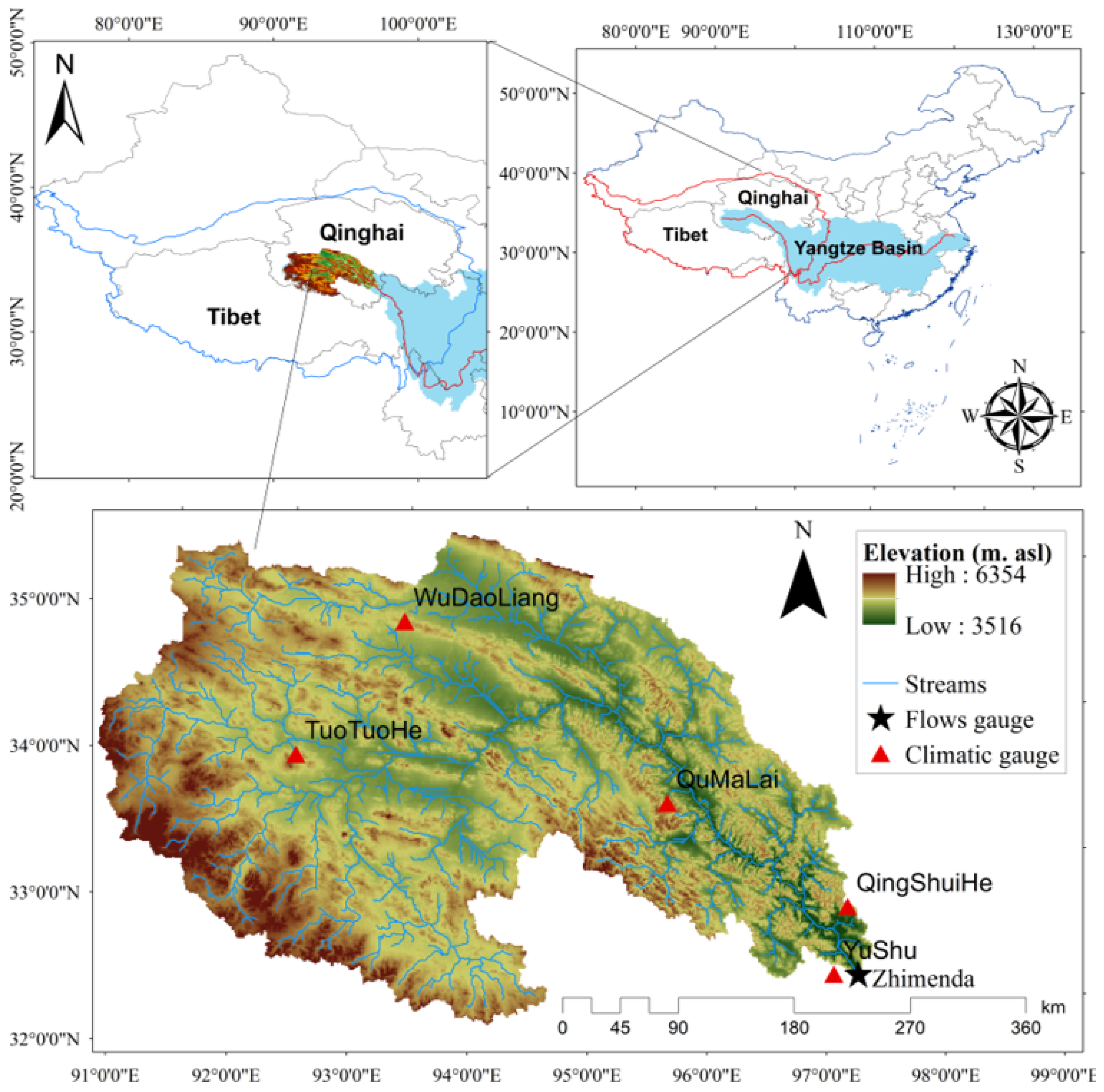

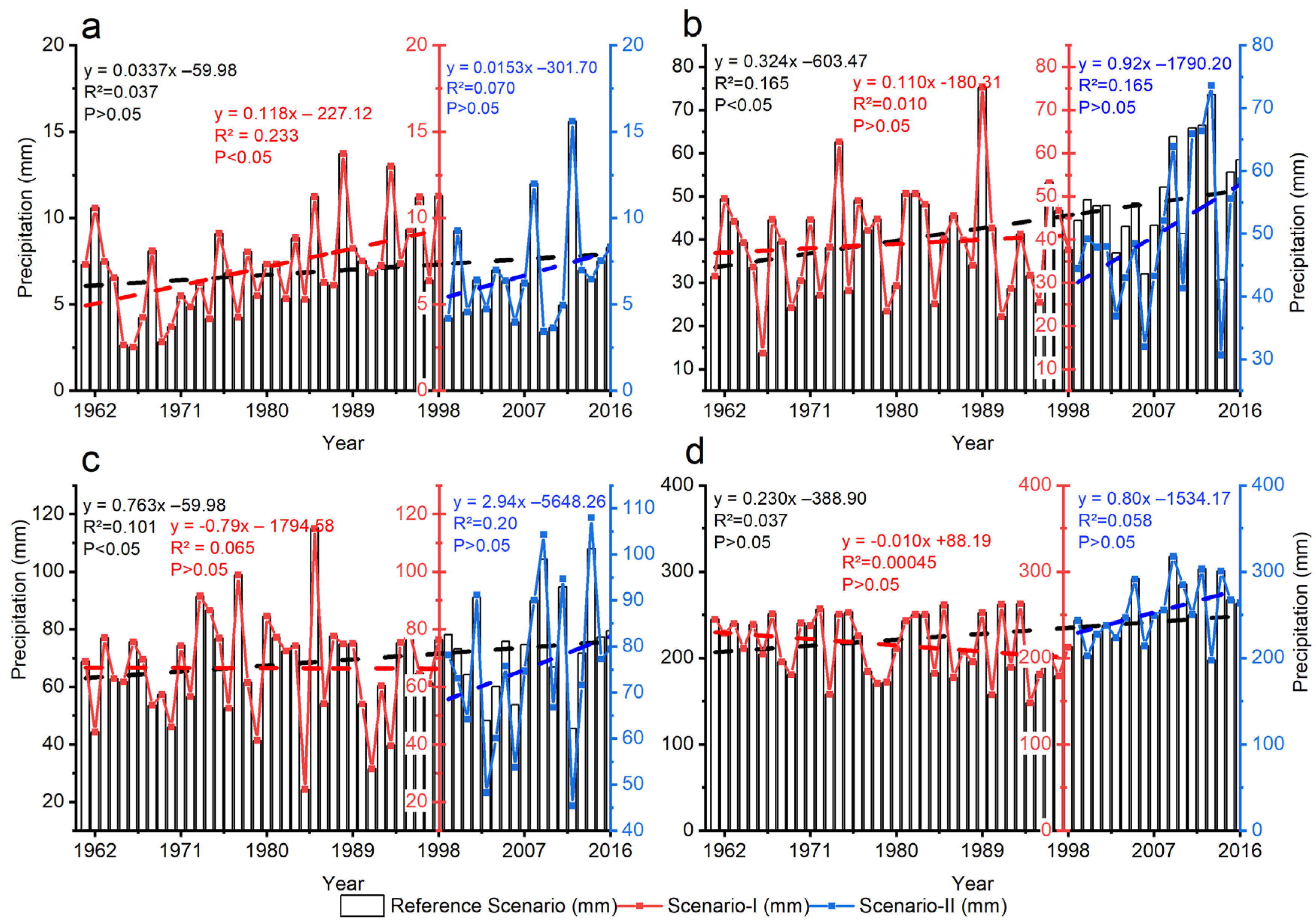
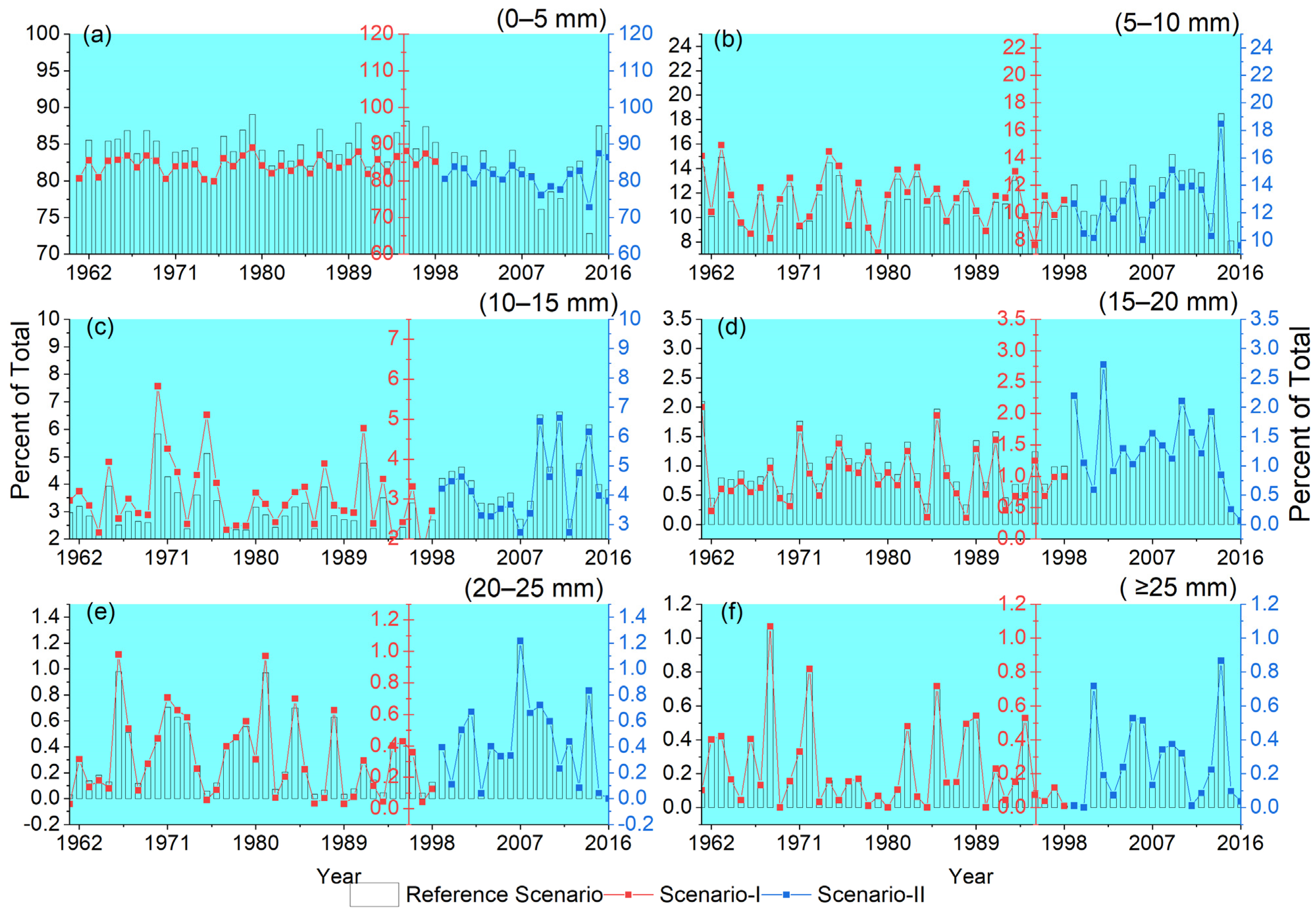
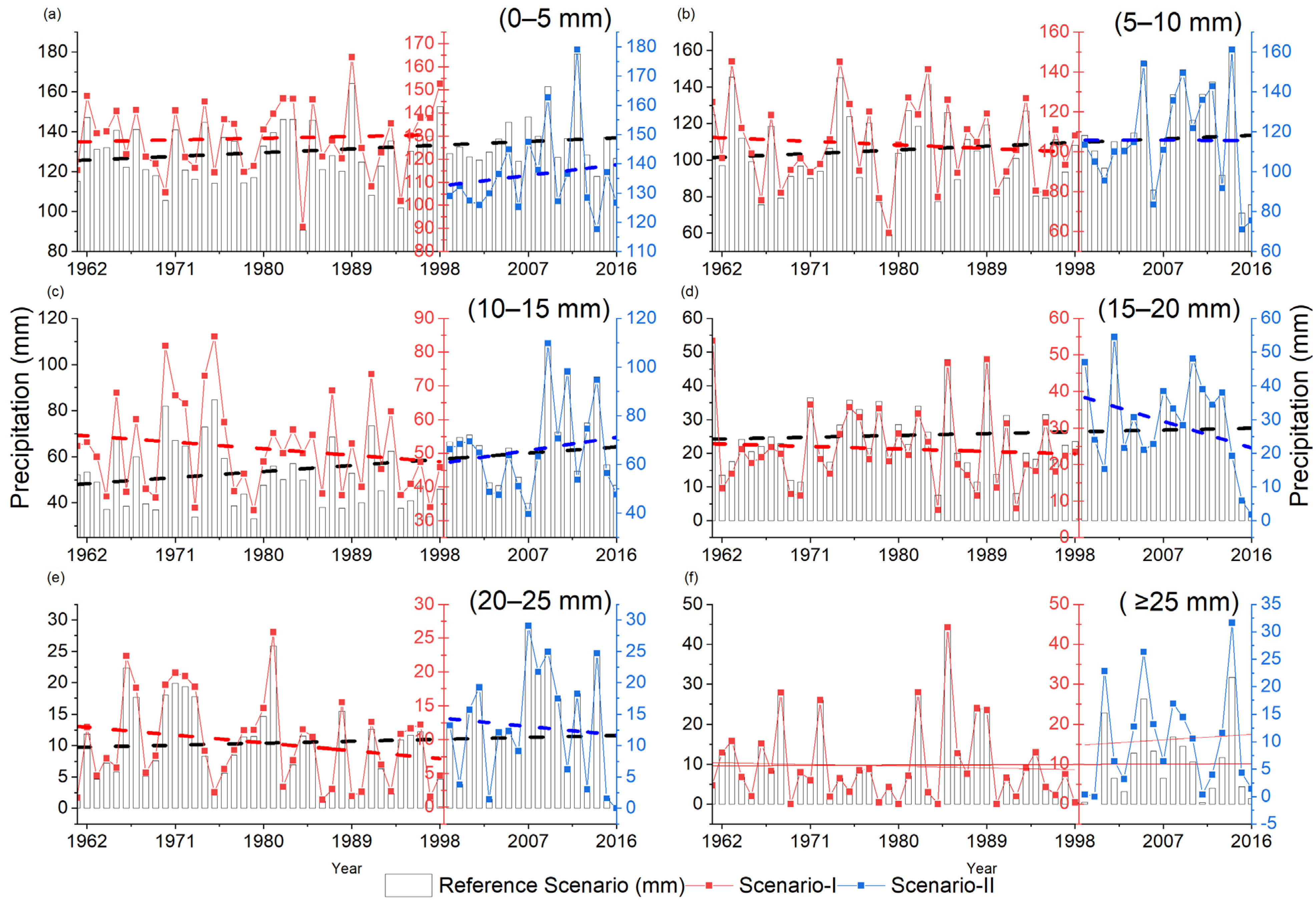
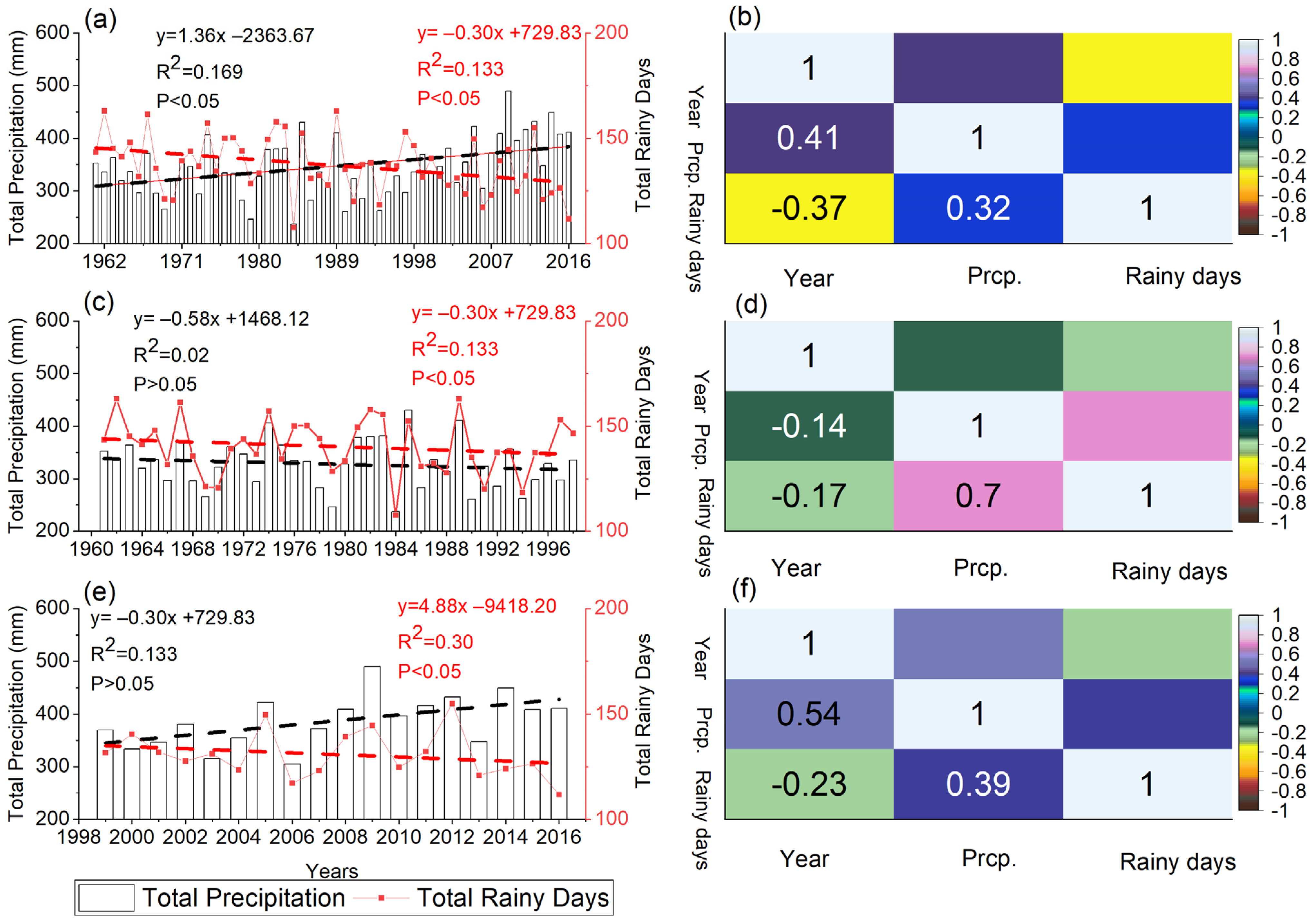
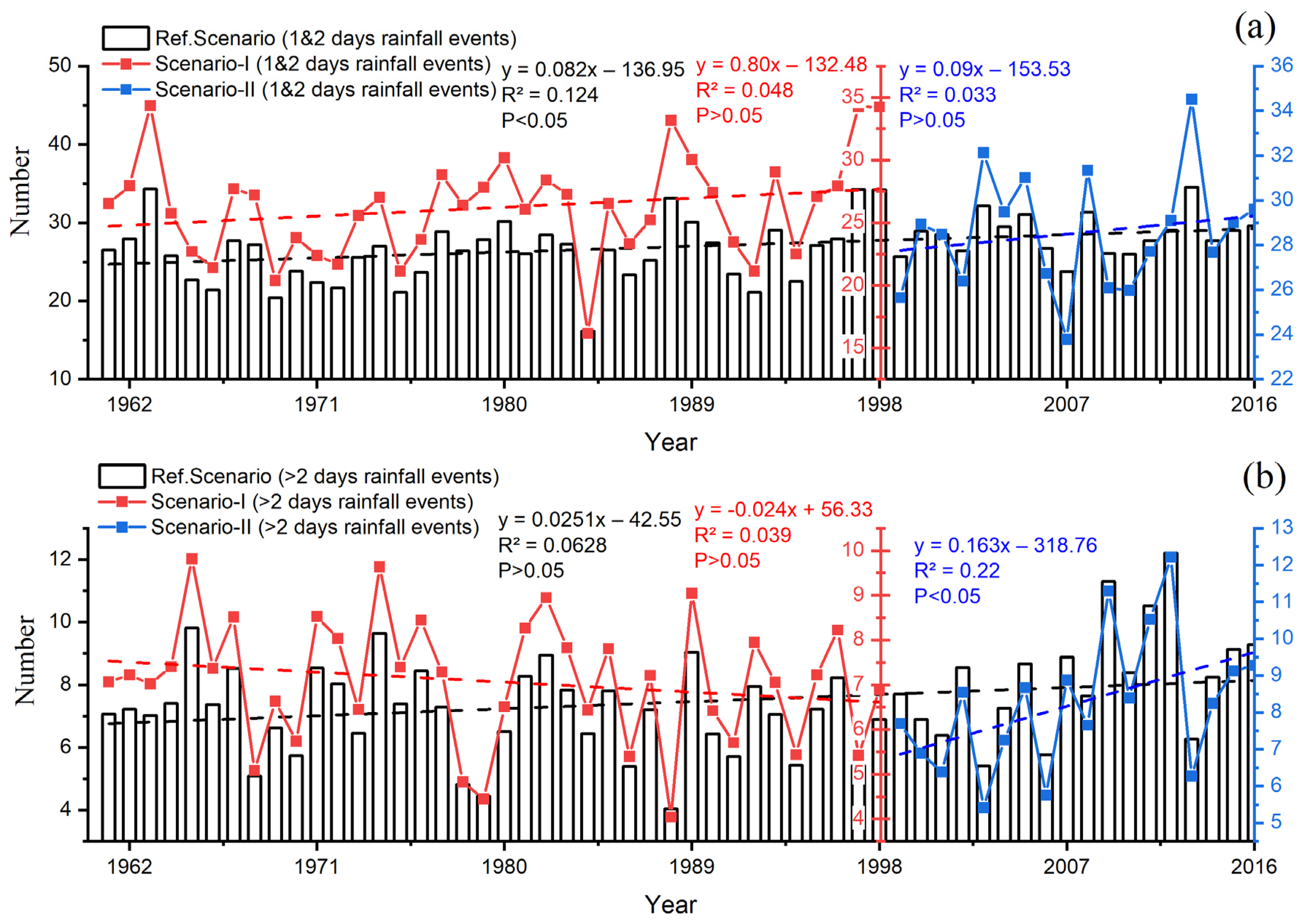
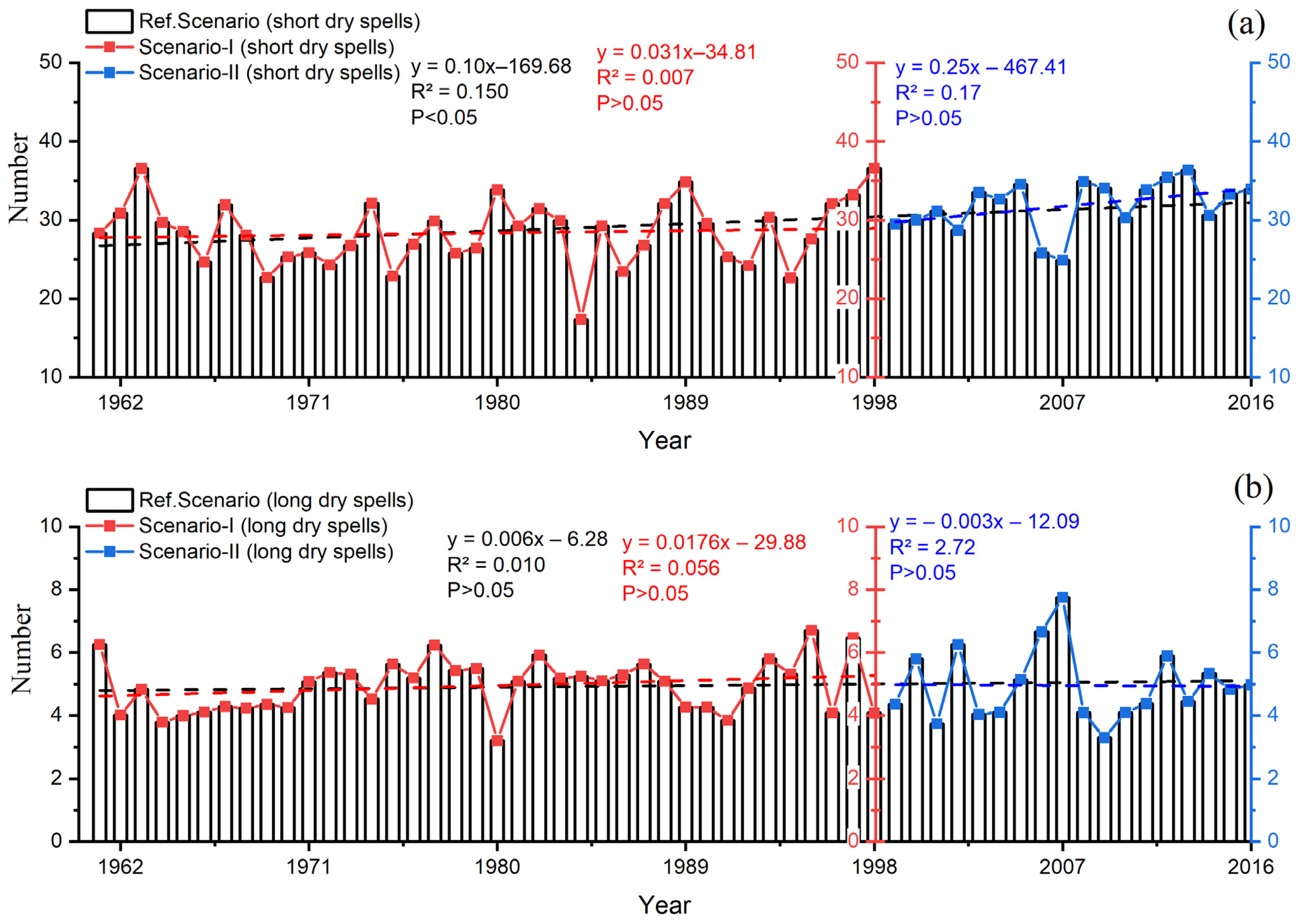
| SN | Stations | Elevations | Precipitation (mm) | ||
|---|---|---|---|---|---|
| Minimum | Mean | Maximum | |||
| 1 | Xiaozaohuo | 2767 | 6.1 | 27.7 | 67.5 |
| 2 | Golmud | 2807.6 | 11.4 | 42.8 | 101.8 |
| 3 | Yushu | 3681.2 | 321.7 | 488.9 | 638.3 |
| 4 | Zaduo | 4066.4 | 411.7 | 537.6 | 700.8 |
| 5 | Qumalai | 4175 | 296.2 | 425.2 | 568.4 |
| 6 | Qingshuihe | 4415.4 | 348.2 | 524.2 | 675 |
| 7 | Tuotuohe | 4533.1 | 162.7 | 294.7 | 503 |
| 8 | Wudaoliang | 4612.2 | 136.3 | 291.9 | 429.4 |
| SN | Precipitation Classes | Precipitation Type (mm) |
|---|---|---|
| 1 | Light precipitation | 0–5 and 5–10 |
| 2 | Moderate precipitation | 10–15, 15–20, and 20–25 |
| 3 | Heavy precipitation | ≥25 |
| Precipitation Class (mm) | Contribution of Annual Rainy Days (%) | Contribution of Annual Rainfall Amount (%) | ||||
|---|---|---|---|---|---|---|
| Scenario- | Scenario- | |||||
| R | I | II | R | I | II | |
| 0–5 | 83.49 | 84.47 | 81.30 | 39.78 | 40.87 | 37.87 |
| 5–10 | 11.42 | 10.96 | 12.51 | 31.21 | 31.43 | 30.87 |
| 10–15 | 3.42 | 3.03 | 4.22 | 16.02 | 15.04 | 17.67 |
| 15–20 | 1.08 | 1.00 | 1.28 | 7.18 | 6.96 | 7.56 |
| 20–25 | 0.34 | 0.31 | 0.43 | 2.91 | 2.72 | 3.29 |
| ≥25 | 0.24 | 0.23 | 0.26 | 2.88 | 2.97 | 2.75 |
Disclaimer/Publisher’s Note: The statements, opinions and data contained in all publications are solely those of the individual author(s) and contributor(s) and not of MDPI and/or the editor(s). MDPI and/or the editor(s) disclaim responsibility for any injury to people or property resulting from any ideas, methods, instructions or products referred to in the content. |
© 2023 by the authors. Licensee MDPI, Basel, Switzerland. This article is an open access article distributed under the terms and conditions of the Creative Commons Attribution (CC BY) license (https://creativecommons.org/licenses/by/4.0/).
Share and Cite
Ahmed, N.; Zhu, L.; Wang, G.; Adeyeri, O.E.; Shah, S.; Ali, S.; Marhaento, H.; Munir, S. Occurrence and Distribution of Long-Term Variability in Precipitation Classes in the Source Region of the Yangtze River. Sustainability 2023, 15, 5834. https://doi.org/10.3390/su15075834
Ahmed N, Zhu L, Wang G, Adeyeri OE, Shah S, Ali S, Marhaento H, Munir S. Occurrence and Distribution of Long-Term Variability in Precipitation Classes in the Source Region of the Yangtze River. Sustainability. 2023; 15(7):5834. https://doi.org/10.3390/su15075834
Chicago/Turabian StyleAhmed, Naveed, Lianqi Zhu, Genxu Wang, Oluwafemi E. Adeyeri, Suraj Shah, Shahid Ali, Hero Marhaento, and Sarfraz Munir. 2023. "Occurrence and Distribution of Long-Term Variability in Precipitation Classes in the Source Region of the Yangtze River" Sustainability 15, no. 7: 5834. https://doi.org/10.3390/su15075834
APA StyleAhmed, N., Zhu, L., Wang, G., Adeyeri, O. E., Shah, S., Ali, S., Marhaento, H., & Munir, S. (2023). Occurrence and Distribution of Long-Term Variability in Precipitation Classes in the Source Region of the Yangtze River. Sustainability, 15(7), 5834. https://doi.org/10.3390/su15075834











